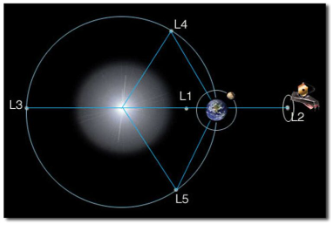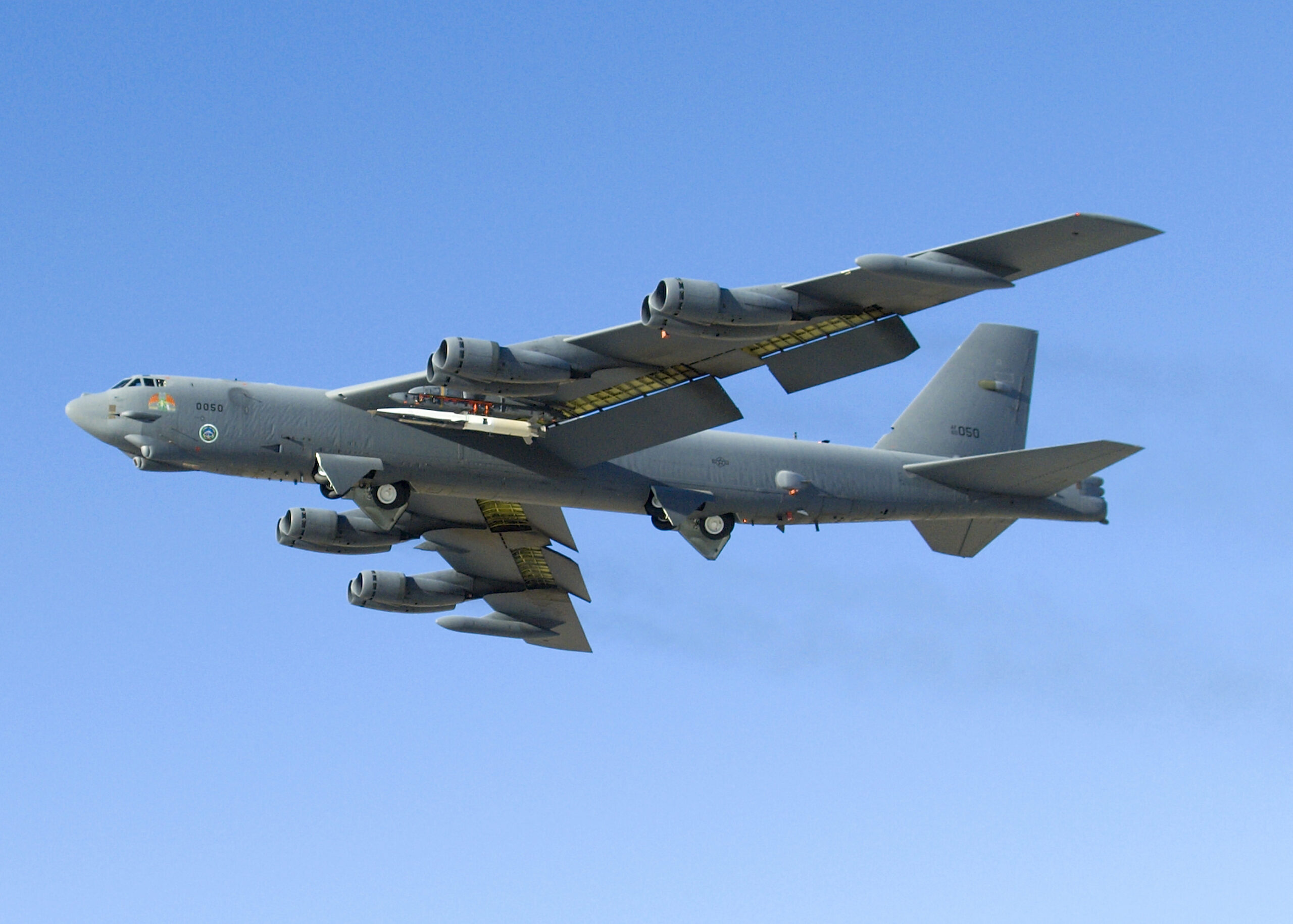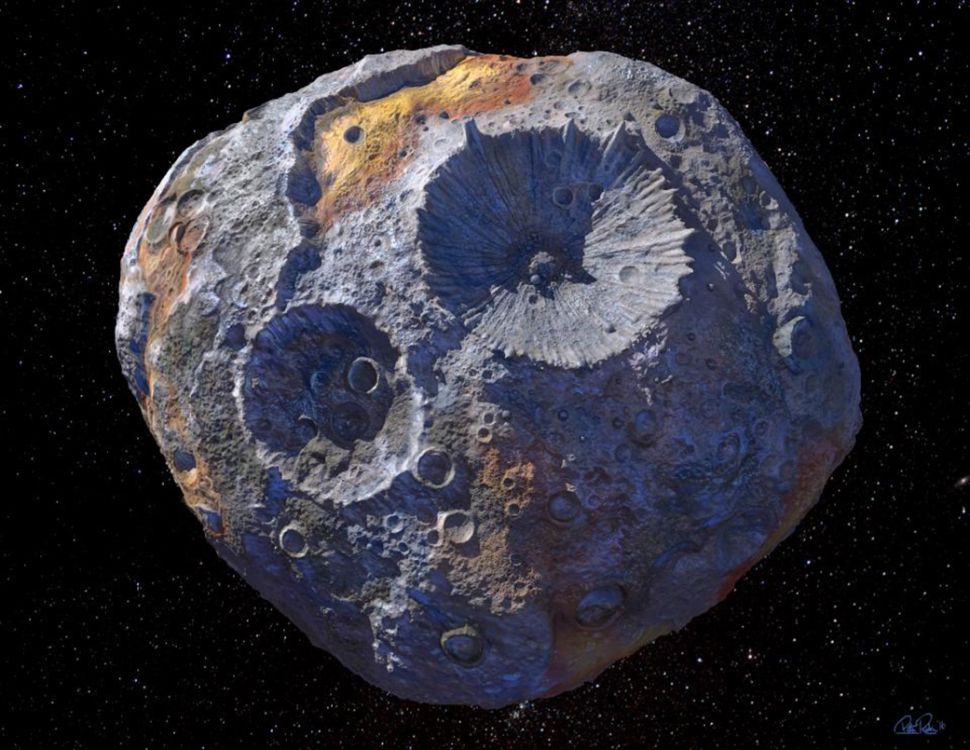Advances in Nuclear Reactors Could Power NASA Missions on Moon, Mars
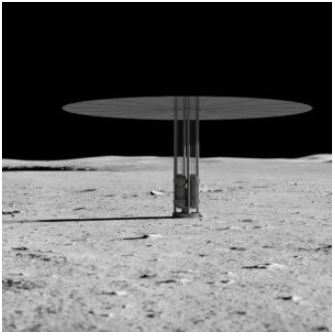 This illustration shows X-energy’s proposed pebble bed reactor.
Credit: X-energy
This illustration shows X-energy’s proposed pebble bed reactor.
Credit: X-energy After a decades-long hibernation, nuclear fission power has come back into fashion for NASA and other agencies as a way to deliver power to remote locations and drive spacecraft at speeds other fuels cannot deliver. What brought back programs shelved since the 1970s are new, safer fuels and designs for miniature reactors small enough to be transported by aircraft and safely launched to orbit.
To meet its extraterrestrial ambitions, NASA is dusting off a decades-old alliance with the Atomic Age in search of engines to have months-long travel times to destinations including Mars. New reactors in development require no combustion and deliver reliable nuclear power to remote bases on the Moon and elsewhere.1
The Defense Advanced Research Project Agency (DARPA) in May announced it was seeking Phase 2 and 3 proposals for its Demonstration Rocket for Agile Cislunar Operations, or DRACO program, to develop propulsion for a reactor-driven spacecraft by 2026 that can serve as a testbed for NASA and military projects.2
“Unlike propulsion technologies in use today, NTP can achieve high thrust-to-weights similar to chemical propulsion but with two to five times the efficiency. This enables NTP systems to be both faster and smaller than electric and chemical systems, respectively,” DARPA officials explained in a statement.
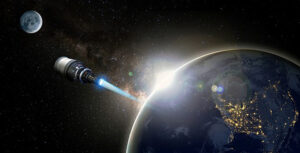
The goal of DARPA’s DRACO program is to demonstrate a nuclear thermal propulsion NTP system on orbit. Credit: DARPA
Another Defense Department project with ties to NASA, named “Pele,” would create mini-reactors to replace diesel-fired generators.
NASA’s latest reactor programs lack nicknames and acronyms. Driving the atomic push are NASA’s Fission Surface Power and Nuclear Propulsion programs, conducted jointly with the Department of Energy and other agencies.3
NASA’s nuclear renaissance comes after a revolution in materials science led to new reactor designs with fuels that can achieve higher temperatures while reducing the radioactive dangers that accompany unlocking the energy encased inside atoms.4
Reactors use controlled chain reactions that use speeding neutrons to split uranium atoms, releasing energy in the form of heat. That heat can be converted into electricity through several methods or can be used in place of fire to rapidly expand gases for thrust.
The nuclear work has reignited interagency partnerships, with the Defense Department, Department of Energy, and DARPA committing cash and expertise to atomic advancements for space, civil, and military use.5 Backed by an influx of congressional cash, these advancements could unlock solutions on Earth to ease reliance on fossil fuel and curb greenhouse gasses.
“In the nuclear industry right now, there is a lot of optimism and excitement, because it could be a green energy solution,” said David Petti, who heads high-temperature reactor research for the Department of Energy’s Idaho National Laboratory.6
NASA received $110 million for pursuit of nuclear projects in 2022 and has asked Congress for an additional $45 million in 2023.7
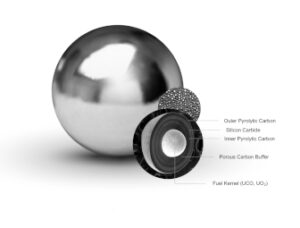
Highly magnified, this illustration shows a “pebble” fuel, which contains a poppy seed-sized grain of uranium surrounded by shielding materials including carbon and ceramics. The new fuels are built to withstand extreme heat. Credit: X-energy
New Spacecraft Powered by a New Generation of Nuclear Fuels
NASA’s latest nuclear plans aren’t far-fetched or far into the future. Contracts have been made with a series of vendors and work is underway on reactors in Washington and Idaho that will test the fuels. The agency plans to have mission-ready nuclear plants for use in space and elsewhere before the end of the decade.8
Key to NASA’s ambitions are new fuels, said Anthony Calomino, who heads the agency’s nuclear reactor research efforts.9 Instead of the old-fashioned uranium or plutonium fuel rods used in reactors since the 1950s, NASA is examining pelletized fuels that resemble golf balls or pill bottles that encase tiny grains of uranium inside a combination of carbon and ceramics. The high-tech coatings, first envisioned in the 1940s but not possible until recent years, act as tiny containment vessels and allow fission at temperatures that would melt traditional reactors, Calomino said.
“The reason the coated carbide fuels are attractive is one they are self-contained,” he said.
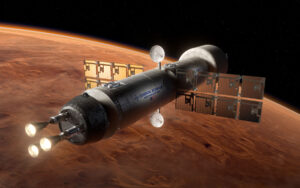
General Atomics is one of the companies vying to build nuclear engines for NASA, enabling quicker travel to the Moon and Mars. Credit: General Atomics
Another new fuel, called high-assay low-enriched uranium, or HALEU, includes up to six times as much of the more radioactive uranium components than the traditional U-235 used in commercial reactors. It’s basically a blend of highly enriched uranium, the kind used to build weapons, and regular, less volatile, uranium.
Researchers at General Atomics, developing the fuel for NASA, say the fuel allows reactors for power generation on the Moon and Mars that carry pounds of fuel rather than the tons in commercial reactor cores. The smaller reactor cores won’t create the gigawatts of power of their larger cousins but still generate enough fission for megawatts of power.10
“It’s all about the technology and materials,” said Ron Faibish, head of business development for General Atomics nuclear arm, one of the contractors pursuing NASA nuclear business. “We have a lot of internal research and development on what we believe are technologies of the future.”
NASA Returns to Fission Development with Eye Toward Powering Lunar Habitation
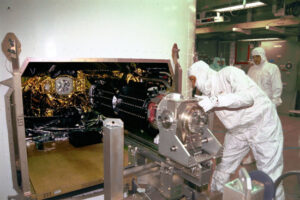
Workers install one of three Radioisotope Thermoelectric Generators (RTGs) on the Cassini spacecraft, which was sent to space in 1997 to explore Saturn and its moons. Credit: NASA
Since the Transit IV-A satellite was launched in 1961, NASA has relied on a form of atomic power for its most important missions.11 Radioisotope thermal generators, called RTGs, which use the heat from decaying uranium to generate electricity, headed to the Moon with Apollo astronauts and continue to power NASA’s exploration programs from the Voyager satellites that documented much of the solar system to the Perseverance rover now roaming Mars.12
But the RTG isn’t a nuclear reactor. With no moving parts and none of the fission that takes place in a reactor, it passively generates heat from radioactive compounds.13 That heat is turned into electricity through a thermocouple. It is reliable and works for years, but at 110 watts, it generates just enough electricity to run the average coffee maker.14
For future missions on the Moon and beyond, NASA envisions power systems that can run machinery, charge rovers, heat crewed bases, and survive for a decade or more with little maintenance.15 That kind of power requires atomic energy.
“What we want is a very compact lightweight reactor,” Calomino said. But “lightweight” and “reactor” haven’t paired well over the years. The average General Electric reactor uses a water condenser in its system that alone weighs 3,450 tons, 300 tons more than the fully fueled Saturn V rocket that launched lunar missions.16 To heat water headed to the condenser, one Westinghouse reactor design filed with the Nuclear Regulatory Commission uses 110 tons of nuclear fuel alone.17
That hasn’t foiled past NASA ambitions. The SNAP Program of the 1960s, an acronym for Systems for Nuclear Auxiliary Power, was aimed at finding the perfect light yet powerful reactor that would drive dreams of exploration while not killing astronauts with stray gamma rays.18
“Someday, perhaps 15 years hence, a rocket will thrust a manned spacecraft from its parking orbit around the Earth and inject it into an elliptical transfer orbit intended to intercept the planet Mars seven months later,” the Atomic Energy Commission wrote in a 1966 pamphlet on nuclear reactors for space.
NASA Draws on Atomic Legacy
Beginning in the 1940s, the Atomic Energy Commission envisioned atomic power driving rockets, trains, planes, ships, and submarines.19 Other reactors were designed to power military bases from the frozen wastes of Greenland to the tropics.
Navy-backed programs to put reactors on ships and submarines showed rapid success with the submarine USS Nautilus sending the famous signal “Underway on nuclear power,” on Jan.17. 1955.20
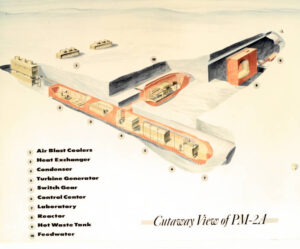
This Army Illustration shows how a portable reactor was installed in tunnels cuts into a Greenland Glacier at the height of the Cold War.
The Army’s work on portable reactors had success, too.21 A ship-based reactor powered bases in Panama, while portable reactors were successfully shipped, assembled, and operated at a radar site in Wyoming and at Camp Century, a base cut into a Greenland glacier designed to test the possibility of hiding nuclear-tipped missiles under ice at the height of the Cold War. The Wyoming plant, dubbed PM-1, was shipped to the site in 16 containers, each weighing 15 tons, making it the lightest in the program.22 Another Army program also triggered America’s first major reactor accident in 1961 when the portable SL-1 reactor exploded at a federal test site in Idaho, killing three troops.23
Officials determined that 790 people were exposed to radiation, according to a Department of Energy report on the incident. All were involved in the attempted rescue and recovery of the three men’s highly radioactive bodies and the subsequent cleanup of the accident or burying of debris.
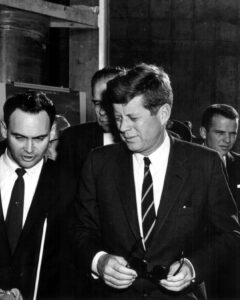
In 1962, President John F. Kennedy visited the Nevada site where nuclear rocket engines underwent testing. Credit: National Nuclear Security Administration
An Air Force program to develop a nuclear-powered plane failed after the Pentagon invested $7 billion between 1947 and 1961. The reactors were just too heavy to fly, and the jet exhaust spit out an alarming radioactive plume.24
One promising space program did get close to launch: Project Rover, NASA’s Nuclear Engine for Rocket Vehicle Application, or NERVA.25
The idea, in 1955 as now, was to use the heat from a reactor to turn liquid hydrogen into a high-temperature gas blasting out of a rocket nozzle. The designs of the 1950s and ’60s were simple, with a small reactor core weighing less than six tons heating the liquid hydrogen to more than 1,000 degrees. Unlike a rocket engine, there was no need for combustion. President John F. Kennedy pushed the nuclear rocket plan as an alternative for sending astronauts from Earth orbit to the Moon.
Despite flaws, the NERVA engine worked, generating more than 55,000 pounds of thrust during a series of tests in Nevada.26 Some saw it as an alternative to traditional combustion for missions after the initial Apollo landings.
But NERVA remained troubled. In three tests the uranium fuel melted, spewing radionucleotides out the rocket nozzle.27 Amid downsizing during the Nixon administration, NASA canceled plans to send astronauts to Mars and axed the nuclear engine program.28
But the idea of zooming through space on nuclear power was harder to kill. NASA kept up studies on a small scale, hoping science would some someday be able to capture the full potential of the nuclear rocket.
New Chemistry Changes Nuclear Future
The problem for NASA’s nuclear ambitions came in two sizes of wrong. Safe reactors were too heavy and small reactors were unsafe. But two technological advancements are expected to solve those problems.
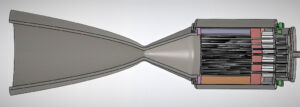
This illustration shows the basic concept of a nuclear thermal engine. Hydrogen would be pumped through the nuclear reactor at right, heated to extreme temperatures, and accelerated through the nozzle on the left side. Credit: NASA
In 2021, the National Academy of Sciences found that new fuels, those golf balls of carbon and ceramics surrounding a poppyseed of uranium, could withstand the heat needed to make the old concept of nuclear thermal propulsion work. And a new technology, the ion thruster, could make electric engines an alternative that would offer a slower, but long-lasting boost for spacecraft headed to Mars and beyond.29
“Both nuclear electric propulsion (NEP) and nuclear thermal propulsion (NTP) systems show great potential to facilitate the human exploration of Mars with significant advantages relative to chemical propulsion,” found the academies’ panel, which included 31 members who met 14 times by videoconference during the lockdown of 2020 to reach their conclusion.
Calomino, head of NASA’s nuclear research program, said both propulsion systems have promise.
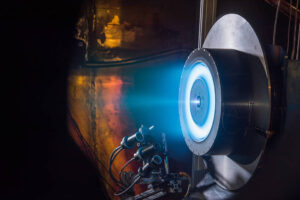
Electric thrusters, including this Hall thruster undergoing NASA testing, could be driven by nuclear power. Credit: NASA
As envisioned, the nuclear thermal engine would blast out 75,000 pounds of thrust for a 15-minute burn in space, kicking a spacecraft toward its destination with a big boost of energy.30
The nuclear electric solution would use megawatts of electricity to drive a massive bank of Hall thrusters, which use electromagnetism to accelerate tiny amounts of xenon, which is converted to a plasma in the process.31
NASA also has determined that nuclear reactors are the best solution for powering bases on the Moon and Mars.32
“Plentiful energy will be key to future space exploration,” stated Jim Reuter, associate administrator for NASA’s pace Technology Mission Directorate in Washington, D.C., which funds NASA’s fission surface power project. “I expect fission surface power systems to greatly benefit our plans for power architectures for the Moon and Mars and even drive innovation for uses here on Earth.”
Key to both propulsion and surface power is high temperature within the reactor. Typical nuclear reactors, such as the common Westinghouse design in use for electrical generation, operate at less than 600 degrees.33
Calomino wants to turn up the heat. “Propulsion is looking for (5,000 degrees),” he said.
With that much heat, the spacecraft can carry a lighter load of fuel. Only liquid hydrogen, the lightest possible fuel, would be carried. The only oxygen aboard a nuclear-powered spacecraft would be for crew life-support rather than combustion.
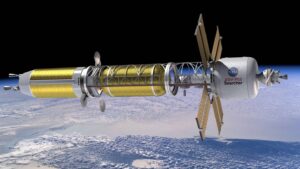
This NASA illustration shows a concept for a nuclear-powered spacecraft. Credit: NASA
Reactors sent to bases on the Moon and Mars would also need to generate plenty of heat. The high- temperature reactions ensure efficient use of nuclear fuels, generating more power and less radioactive waste.
“When we look at power generation, the temperatures are way down,” he said, noting that his definition of “way down” is still 2,600 degrees.
That’s why new fuel designs that can take the heat without melting are critical. NASA is looking at nuclear fuels wrapped in a combination of carbon and silicon with an outer shell of artificial diamonds for the highest temperatures.
At X-energy, one of the companies collaborating on the NASA, Department Energy, and Defense Department push for smaller reactors, engineers are racing to design new fuels and a gas-cooled reactor that can take the heat.34
“We have materials that are achievable and safety systems and control systems that are achievable,” said Brad Rearden, director of engineering for the firm’s mobile reactor project.
X-energy is constructing a demonstration reactor near Richland, Washington, based on a “pebble-bed” design. First envisioned in Germany in the 1960s, the pebble bed uses balls of carbon and ceramic materials to encase grains of nuclear material.
Each ball contains uranium, but on its own isn’t enough to cause a fission reaction. But enough of the balls together cause a controlled fission reaction as neutrons blast neighboring atoms apart, releasing energy and heat.
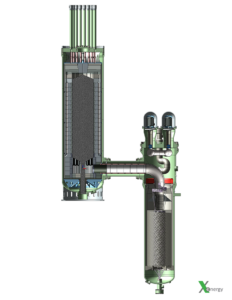
This illustration shows X-energy’s proposed pebble bed reactor. Credit: X-energy
The spherical shape of the balls of fuel allows a gas coolant — X-energy plans to use helium — to flow through the reactor.
The gas coolant is key: Almost all reactors that generate power or drive ships and submarines require tons of water that flashes to steam by passing through the core. More tons of water are needed to pass through a heat exchanger to cool the water from the radioactive side and drive turbines to turn nuclear heat to power. All the launch vehicles on Earth couldn’t haul enough water to make that kind of reactor work in space.
Harlan Bowers, program manager of X-energy’s mobile reactor project, said gas is a good alternative because space, Mars, and the Moon are cold.35 The temperature in outer space averages more than 400 degrees below zero. While the Moon has daytime highs at a roasting 200 degrees, those temperatures plummet to 300 degrees below zero at night. Mars is consistently frigid with average temperature of 85 degrees below zero.36
Bowers said the key to harnessing the cold will be large radiators tied to the gas loop that runs through reactors for use on extraterrestrial bases.
“We’re talking about a boatload of reject heat we are trying to get rid of,” he said.
U.S. Racing to Catch China as Europe Tries New Path
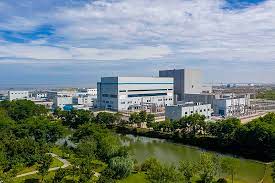
China’s Huaneng Shidao Bay High Temperature Gas cooled Reactor demonstration project, touted the world’s first HTGR power station, began delivering electricity in December 2021. Credit: China Huaneng
As the U.S. launches its projects for next generation nuclear reactors that can serve space missions, China and Russia already have constructed and are operating small modular reactors. Russia in 2018 announced the completion of a floating power plant to deliver electricity to one of its northernmost cities, describing it as “the world’s first project of the mobile transportable power unit of low power.”37
China’s new high-temperature gas reactor uses coated fuel pebbles like those envisioned for American projects. China’s state-run news agency ECNS touted that the new reactor “won’t melt, nor will it cause a large-scale radioactive release during an accident.”
At the Idaho National Laboratory in the United States, Petti said the ideas behind America’s new nuclear space reactors have roots in decades-old technology that’s been studied around the globe.
“The Chinese are using 1970s and 1980s technology,” he said, noting lab testing on America’s latest atomic fuels demonstrated advantages in generating power more efficiently and withstanding higher temperatures.
While China and Russia may not have the latest in American nuclear technology, they claim to have nuclear tools to use in space and to power missions on the Moon and Mars. The China National Space Agency’s latest five-year plan includes development of nuclear space propulsion and nuclear surface power for an international lunar research station in cooperation with Russia.38
The Russian state-run news agency TASS in 2020 announced that nation’s plans for what it described as a nuclear-powered space tug. TASS reported the atomic spacecraft would be in serial production by 2030.39
Other nations are eyeing nuclear power in space, with India and others planning experiments to harness atomic power for propulsion and electricity.40
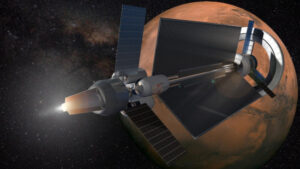
The European Space Agency is studying fusion power for spacecraft, shown in this artist’s concept. Credit: ESA
The European Space Agency may leapfrog the other global nuclear programs by using fusion, the kind of atomic engine that powers the Sun, instead of cracking atoms with old-fashioned fission. The agency in late 2021 announced a new research program into fusion powered propulsion, allowing spacecraft to race ahead of their fission-powered cousins.41 This mission concept would be the first nuclear fusion propulsion system in space; it would take only two months to fly to Mars, agency officials stated.
Faibish, with General Atomics, said public opinion and public policy have hampered U.S. efforts to unlock the full potential of nuclear power for missions in space and on Earth. “The ebb and flow in funding is an issue in policy,” he said. “Often it was an arbitrary move. Now we are scrambling to catch up to Russia and China.”
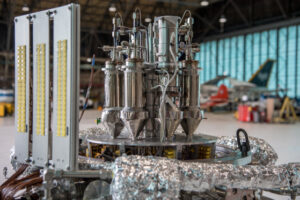
NASA’s Kilopower reactor could deliver 100 kilowatts of electricity for extraterrestrial missions. Credit NASA
NASA is not completely behind the curve. In 2018, the agency demonstrated its small Kilopower reactor, which used older technology than the newer systems now under consideration.42 With a uranium core about the size of a loaf of bread, the sodium-cooled reactor used heat to run a Stirling engine, generating 10 kilowatts of power, enough to run the average household.
If taken to the Moon, the Stirling engine would be one of the oldest technologies on the mission. The piston engine, patented by Scottish minister Robert Stirling in 1816, relies on heat to cause reciprocating movement.43
American Atomic Optimism Returns
Nuclear power developed for space could have big impacts on Earth. At the dawn of what was called the “Atomic Age,” leaders envisioned endless possibilities for energy derived from atoms.
“It is not too much to expect that our children will enjoy in their homes electrical energy too cheap to meter, will know of great periodic regional famines in the world only as matters of history, will travel effortlessly over the seas and under them and through the air with a minimum of danger and at great speeds, and will experience a lifespan far longer than ours, as disease yields and man comes to understand what causes him to age,” Atomic Energy Commission Chairman Lewis Strauss said in 1954. “This is the forecast for an age of peace.”44
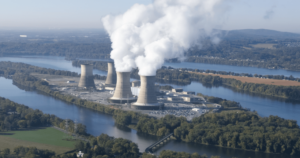
Pennsylvania’s Three Mile Island nuclear plant suffered a partial core meltdown in 1979, changing American attitudes toward atomic power. Credit: Department of Energy
“Too cheap to meter,” turned into a punchline as nuclear power matured. By 1979, the Government Accountability Office estimated that American taxpayers had taken a $12.1 billion hit to subsidize construction and operation of nuclear power plants.45
On March 29, 1979, Americans experienced the nightmare that can accompany the miracle of atomic energy when equipment failures at the Three Mile Island Nuclear Generating Station in Pennsylvania caused a reactor plant to overheat and suffer a partial meltdown. The incident led to a release of radiation that exposed an estimated 2 million people.46
Rising costs, tightened regulations, and public opposition scuttled the growth of the nuclear power industry in the U.S.47 Other nuclear plant incidents highlighted the problems of nuclear power, including the 1986 reactor meltdown at Chernobyl in the Soviet Union and the 2011 Fukushima Daiichi incident, which melted three reactor cores at a massive nuclear power generating station in Japan.48
In an early 2022 poll, the Pew Research Center found that 72 percent of Americans support generating power with wind turbines and solar panels. Only 35 percent of those polled by Pew favored the nuclear option.49
Even as new nuclear power plants on Earth are derided, nuclear power in outer space is lionized. NASA used radioisotope thermal generators on more than 14 missions, with the public cheering discoveries by nuclear-powered rovers including Mars Perseverance and satellites such as the New Horizons spacecraft that probed Pluto.50
In the book and blockbuster movie “The Martian”, the hero of the story huddles with a nuclear generator to keep warm as he struggles to survive alone amid a fictional failed mission.51
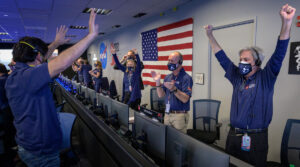
Members of NASA’s Perseverance rover team in California celebrate after receiving confirmation the spacecraft successfully touched down on Mars, on Feb. 18, 2021. Credit: NASA
The difference, experts say, is that space, Mars, and the Moon are already radioactive.52 One columnist opined in 2021 that “once nuclear power plants are deployed in space, either at a Moon base or on a spacecraft voyaging to Mars, they would present no danger to humans on Earth.”53
Some industry leaders are betting that safe nuclear technology proven in space can gain ample support for use on Earth.
High-flying concepts could help solve old problems
X-energy’s Bowers said his firm is hoping to transfer nuclear technology used in space to improve life on Earth.
“One of the things we joke about is ‘How many nuclear thermal propulsion systems does X-energy plan on delivering in the next 10 years?’ The answer is one. It is not a business that would move the needle,” he said. “We look at these space nuclear applications as a way of advancing and demonstrating cutting-edge technology. That gives us the capability of taking the technology and rolling it into commercial reactors.”
General Atomics is also betting that small reactors developed for space can come down to Earth as an alternative to fossil fuels.
“We are developing a modular gas-cooled reactor. That is a sweet spot,” he said, explaining that reactors with small amounts of fuel don’t pose the dangers of their larger brethren. “But we need a lot of government support to enable it.”
The Department of Energy, which is backing NASA efforts, is also betting on the little reactors.54
“These advanced reactors, envisioned to vary in size from tens of megawatts up to hundreds of megawatts, can be used for power generation, process heat, desalination, or other industrial uses,” the agency stated.
The Pentagon wants small reactors to help cut its growing diesel and jet fuel bill: The U.S. military burns 10 million gallons per day in peacetime.55
“A safe, small, transportable nuclear reactor would address this growing demand with a resilient, carbon-free energy source that would not add to the DoD’s fuel needs, while supporting mission- critical operations in remote and austere environments,” the Defense Department stated.
The Department of Energy is looking to the nuclear space technology to change how Americans fuel up.
Small nuclear plants can produce electricity, recharging the nation’s growing number of battery- powered vehicles. They also can produce a replacement for fossil fuels: pure hydrogen, that when ignited, releases water vapor.56
“Ultimately, nuclear energy could support the nation’s manufacturing industries across multiple sectors by providing clean energy to produce hydrogen, fuels, fertilizers, steel, plastics, and other chemicals,” the agency stated.

Tom Roeder is a Space Foundation senior data analyst and editor. He can be reached by email at troeder@spacefoundation.org
- NASA. “Strategic Framework.” https://techport.nasa.gov/framework. March 2022. Accessed April 9, 2022.
- Defense Advanced Research Projects Agency. “Broad Agency Announcement: Demonstration Rocket for Agile Cislunar Operations (DRACO) Phase 2 and Phase 3.” May 4, 2022. https://www.darpa.mil/news-events/2022-05-04. Accessed May 4, 2022.
- NASA. “6 Technologies NASA is Advancing to Send Humans to Mars.” June 17, 2020. https://www.nasa.gov/mission_pages/tdm/fission-surface-power/index.html. Accessed May 26, 2022.
- NASA. “NASA announces nuclear thermal propulsion awards,” June 13, 2021. Accessed April 10, 2022.
- Defense Department. “DoD to Build Project Pele Mobile Microreactor and Perform Demonstration at Idaho National Laboratory,”
April 13, 2022. https://www.defense.gov/News/Releases/Release/Article/2998460/dod-to-build-project-pele-mobile-microreactorand-perform-demonstration-at-idah/. Accessed April 13, 2022. - Interview with author. April 29, 2022
- NASA. “FY 2023 Budget Estimates.” March 17, 2022. https://www.nasa.gov/sites/default/files/atoms/files/fy23_nasa_budget_request_full_opt.pdf. Accessed March 29, 2022.
- Federal Register. “Space Policy Directive 6,” Dec. 23, 2020. https://www.federalregister.gov/documents/2020/12/23/2020-28457/posting-of-the-presidential-policy-directive-6-space-policy-national-strategy-for-space-nuclear. Accessed April 10, 2022.
- Interview with author, May 2, 2022.
- Interview with author, May 4, 2022.
- NASA. “Transit IV-A: The First Radioisotope Power System,” https://rps.nasa.gov/missions/17/transit-iv-a/. Accessed April 13, 2022.
- NASA. “After 60 Years, Nuclear Power for Spaceflight is Still Tried and True,” June 29, 2021.https://rps.nasa.gov/news/49/after-60-years-nuclear-power-for-spaceflight-is-still-tried-and-true/. Accessed May 1, 2022.
- Office of Nuclear Energy. “What is a Radioisotope Power System?” Feb. 16, 2021. https://www.energy.gov/ne/articles/what-radioisotope-power-system. Accessed April 22, 2022.
- Environmental Protection Agency. “Energy Star Market & Industry Scoping Report.” November 2011. https://www.energystar.gov/sites/default/files/asset/document/ENERGY_STAR_Scoping_Report_Coffee_Makers.pdf. Accessed May 4, 2022.
- Department of Energy. “Fission Surface Power.” Nov. 19, 2021. https://sam.gov/opp/f2610d99cf174e959eede4b170d86e2d/view. Accessed April 14, 2022.
- General Electric. “Nuclear Power Product Catalog,” November 2019. https://www.ge.com/content/dam/gepower-new/global/en_US/downloads/steam-new-site/resources/catalog/nuclear-product-catalog.pdf. Accessed May 4, 2022.
- Nuclear Regulatory Commission. “Westinghouse Systems Manual Section 3.1,” September 2009. https://www.nrc.gov/docs/ML1122/ML11223A212.pdf. Accessed May 4, 2022.
- Atomic Energy Commission. “SNAP Nuclear Space Reactors,” 1966. Accessed May 4, 2022.
- Air Force Materiel Command. “History in Two: Manned Nuclear Aircraft Program,” June 21, 2021. https://www.afmc.af.mil/News/Article-Display/Article/2664365/history-in-two-manned-nuclear-aircraft-program/. Accessed May 4, 2022.
- Naval History and Heritage Command. “USS Nautilus,” Oct. 6, 2021. https://www.history.navy.mil/browse-by-topic/ships/submarines/uss-nautilus.html.
Accessed May 4, 2022. - Army Corps of Engineers. “The Origins of the Army Nuclear Power Program,” https://www.usace.army.mil/About/History/Exhibits/Nuclear-Power-Program/Origins-of-ANPP/. Accessed April 23, 2022.
- Belson, John D. “Military Nuclear Power Plants.” June 1964. https://apps.dtic.mil/sti/pdfs/AD0602678.pdf. Accessed May 3, 2022.
- Department of Energy. “SL-1, Idaho: Just the Facts.” https://factsheets.inl.gov/FactSheets/Just%20the%20Facts_SL-1.pdf. Accessed April 30, 2022.
- Brookings Institute. “The Hidden Costs of Our Nuclear Arsenal.” June 30, 1998. https://www.brookings.edu/the-hidden-costs-of-our-nuclear-arsenal-overview-of-project-findings/. Accessed April 26, 2022.
- NASA. “Nuclear Rockets.” Sept. 28, 2021. https://www1.grc.nasa.gov/historic-facilities/rockets-systems-area/7911-2/#projectrover-and-nerva-programs. Accessed April 13, 2021.
- NASA. “An Historical Perspective of the NERVA Nuclear Rocket Engine Technology Program.” July 1991. https://ntrs.nasa.gov/api/citations/19910017902/downloads/19910017902.pdf. Accessed April 15, 2022.
- NASA. “Rover Nuclear Rocket Engine Program: Final Report,” February 1991. https://ntrs.nasa.gov/api/citations/19920005899/downloads/19920005899.pdf. Accessed May 1, 2022.
- Nation Nuclear Security Administration. “Nuclear Rocket Development Station.” August 2013. https://www.nnss.gov/docs/fact_sheets/DOENV_707.pdf. Accessed April 30, 2022.
- National Academies of Science. “Space Nuclear Propulsion for Human Mars Exploration.” July 29, 2021. https://nap.nationalacademies.org/catalog/25977/space-nuclear-propulsion-for-human-mars-exploration. Accessed May 3, 2022.
- Braun, Bobby and Myers, Roger. “Space Nuclear Propulsion for Mars Exploration.” February 2021. https://nap.nationalacademies.org/resource/25977/SNP%20Briefing%2002-16-2021.pdf. Accessed May 8, 2022.
- NASA. “Hall Effect Thruster Technologies.” https://technology.nasa.gov/patent/LEW-TOPS-34. Accessed May 8, 2022.
- Department of Energy. “Battelle Energy Alliance, NASA Seek Industry Partners to Design Nuclear Power System for Lunar Applications.” Nov. 19, 2021. https://inl.gov/article/battelle-energy-alliance-nasa-seek-industry-partners-to-design-nuclear-power-system-for-lunar-applications/. Accessed April 14, 2022.
- Nuclear Regulatory Commission. “Westinghouse Technology Manual, Chapter 17.0, Plant Operations.” March 1998. https://www.nrc.gov/docs/ML0230/ML023040268.pdf. Accessed May 4, 2022.
- Interview with author, May 2, 2022.
- Interview with Author April 27, 2022.
- NASA. “Solar System Temperatures.” Feb. 15, 2022. https://solarsystem.nasa.gov/resources/681/solar-system-temperatures/. Accessed May 10, 2022.
- Rosatom. “The World’s Only Floating Power Unit Academic Lomonosov Takes to the Sea.” April 28, 2018. https://www.rosatom.ru/en/press-centre/news/the-world-s-only-floating-power-unit-akademik-lomonosov-takes-the-sea/. Accessed May 7, 2022.
- China National Space Administration. “International Lunar Research Station.” June 2021. http://www.cnsa.gov.cn/english/n6465645/n6465648/c6812150/content.html. Accessed May 10, 2022.
- TASS. “Roscosmos Says First Russian Nuclear Space Tug Set for Launch in 2030.” Jan 28, 2020.
https://tass.com/science/1113827. Accessed May 10, 2022. - India Space Research Organization. “Research Areas in Space.” January 2021. http://www.csre.iitb.ac.in/isro_cell/Research_Areas_in_Space.pdf. Accessed May 10, 2022.
- European Space Agency. “Nuclear Fusion Space Propulsion,” Nov. 17. 2021.
https://www.esa.int/ESA_Multimedia/Images/2021/11/Nuclear_fusion_space_propulsion. Accessed May 7, 2022. - NASA. “Kilopower.” https://www.nasa.gov/directorates/spacetech/kilopower. Accessed May 7, 2022.
- Massachusetts Institute of Technology. “Stirling Engine History.” https://ocw.mit.edu/courses/2-670-mechanical-engineering-tools-january-iap-2004/pages/study-materials/. Accessed May 8, 2021.
- Nuclear Regulatory Commission. “Too Cheap to Meter: A History of the Phrase.” Sept. 24, 2021. https://www.nrc.gov/reading-rm/basic-ref/students/history-101/too-cheap-to-meter.html. Accessed May 9, 2022.
- Government Accountability Office. “Nuclear Power Costs and Subsidies.” June 13, 1979. https://www.gao.gov/products/emd-79-52. Accessed May 9, 2022.
- Office of Nuclear Energy. “Five Facts to Know About Three Mile Island.” May 4, 2022. https://www.energy.gov/ne/articles/5-facts-know-about-three-mile-island. Accessed May 10, 2022.
- Energy Information Administration. “Most U.S. Nuclear Power Plants Were Built Between 1970 and 1990.” April 27, 2017. https://www.eia.gov/todayinenergy/detail.php?id=30972. Accessed May 8, 2022.
- World Nuclear Association. “Fukushima Daiichi Accident.” April 2021. https://world-nuclear.org/information-library/safety-and-security/safety-of-plants/fukushima-daiichi-accident.aspx. Accessed May 8, 2022.
- Rebecca Lepperty. “Americans continue to express mixed views about nuclear power,” March 23, 2022.
https://www.pewresearch.org/fact-tank/2022/03/23/americans-continue-to-express-mixed-views-about-nuclear-power/. Accessed May 9, 2022. - Christine Lundsford. “In photos: Perseverance rover’s Mars landing celebrations at NASA and around the nation,” Feb. 27, 2021. https://www.space.com/perseverance-rover-mars-landing-celebration-photos. Accessed May 10, 2022.
- Andy Weir. “The Martian.” 2011, https://www.amazon.com/Martian-Andy-Weir/dp/0553418025. Accessed May 7, 2022.
- Marcia Dunn. “New measurements show moon has hazardous radiation levels” Sept. 25, 2020. https://apnews.com/article/moonap-
top-news-science-mars-0165939112ae4b44dbf49bd54762af43. Accessed May 10, 2022. - Mark Whittington. “The NASA-China space race is about to go nuclear.” Dec. 5, 2021. https://thehill.com/opinion/technology/584232-the-nasa-china-space-race-is-about-to-go-nuclear/. Accessed May 10, 2022.
- Department of Energy. “Advanced Small Modular Reactors.” 2021. https://www.energy.gov/ne/advanced-small-modular-reactors-smrs. Accessed May 10, 2022.
- Defense Department. “DoD to Build Project Pele Mobile Microreactor and Perform Demonstration at Idaho National Laboratory.”
April 13, 2022. https://www.defense.gov/News/Releases/Release/Article/2998460/dod-to-build-project-pele-mobile-microreactorand-perform-demonstration-at-idah/. Accessed April 13, 2022. - Department of Energy. “Could Hydrogren Help Save Nuclear?” June 24, 2020. https://www.energy.gov/ne/articles/could-hydrogen-help-save-nuclear. Accessed May 7, 2022.
